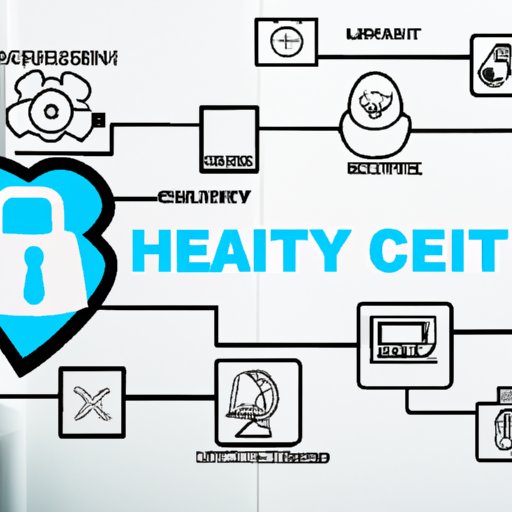Introduction
Healthcare cybersecurity is the practice of protecting health information systems, networks, and data from unauthorized access, use, disclosure, disruption, modification, or destruction. As the healthcare industry continues to expand, so does the potential for cyberattacks and data breaches. To protect patient data and safeguard healthcare systems, healthcare organizations must take proactive measures to ensure their data is secure and compliant with government regulations.

Exploring the Basics of Healthcare Cybersecurity
When it comes to healthcare cybersecurity, there are a variety of cyber threats that organizations need to be aware of. According to a study conducted by the Ponemon Institute, the most common types of cyber threats include malware, phishing, ransomware, and distributed denial-of-service (DDoS) attacks. These threats can cause significant damage to healthcare systems, resulting in the loss of patient data, system downtime, and financial losses.
To mitigate the risk of cyberattacks and data breaches, healthcare organizations must implement the necessary security measures. Common security measures used to protect healthcare data and systems include firewalls, antivirus software, encryption, two-factor authentication, and access control systems. By utilizing these security measures, healthcare organizations can reduce the risk of cyberattacks and protect their data from unauthorized access.
A Comprehensive Guide to Healthcare Cybersecurity
Developing a comprehensive cybersecurity strategy is essential for healthcare organizations wanting to ensure their data and systems are secure. According to the World Health Organization, the first step in creating a cybersecurity strategy is to assess the organization’s current security posture. This assessment should include an evaluation of existing security policies and procedures, as well as any potential vulnerabilities. Once the assessment is complete, the organization can develop a plan to address any identified weaknesses and create a roadmap for improving its security posture.
In addition to developing a comprehensive cybersecurity strategy, healthcare organizations must also adhere to best practices for protecting patient data. These best practices include limiting access to sensitive information, regularly monitoring for suspicious activity, and conducting regular backups of all data. By following these best practices, healthcare organizations can reduce the risk of data breaches and ensure the privacy and security of their patients’ data.

Understanding the Challenges and Opportunities of Healthcare Cybersecurity
While healthcare cybersecurity can provide many benefits to healthcare organizations, there are also potential risks associated with it. A recent study conducted by the American Medical Association found that one of the primary challenges associated with healthcare cybersecurity is the lack of resources and expertise needed to effectively implement security measures. Additionally, healthcare organizations may face financial challenges as they invest in new technologies and hire additional personnel to manage their cybersecurity initiatives.
Despite the potential risks, there are also many benefits to implementing healthcare cybersecurity solutions. These benefits include improved patient safety and privacy, enhanced compliance with government regulations, and increased efficiency and cost savings. By taking the necessary steps to secure their data and systems, healthcare organizations can protect their patients and ensure their compliance with applicable laws and regulations.
How Healthcare Organizations Can Prepare for Healthcare Cybersecurity
To prepare for healthcare cybersecurity, healthcare organizations must take the necessary steps to create an effective cybersecurity plan. The first step is to identify the organization’s security objectives and goals. This will help the organization determine the areas of focus and the resources needed to achieve its desired level of security. Once the organization has identified its security objectives, it can then develop a plan of action to meet these objectives.
In addition to developing a comprehensive cybersecurity plan, healthcare organizations must also implement the necessary tools and technologies to secure their systems. Common tools and technologies used to protect healthcare systems include network segmentation, intrusion detection systems, and data loss prevention solutions. By utilizing these tools and technologies, healthcare organizations can improve the security of their data and systems and reduce the risk of cyberattacks.

The Benefits of Implementing Healthcare Cybersecurity Solutions
By implementing healthcare cybersecurity solutions, healthcare organizations can reap a number of benefits. These benefits include improved patient safety and privacy, enhanced compliance with government regulations, and increased efficiency and cost savings. Improved patient safety and privacy can help healthcare organizations protect their patients’ sensitive data and ensure the confidentiality of their medical records. Enhanced compliance with government regulations can help healthcare organizations avoid costly fines and penalties associated with non-compliance. Finally, increased efficiency and cost savings can result from the implementation of more efficient security processes and technologies.
According to a report published by the National Institute of Standards and Technology, healthcare organizations that implement comprehensive cybersecurity strategies can also benefit from improved customer satisfaction, better decision making, and reduced operational costs. By taking the necessary steps to secure their data and systems, healthcare organizations can protect their patients, comply with applicable laws and regulations, and improve the overall efficiency of their operations.
Conclusion
Healthcare cybersecurity is an essential component of protecting patient data and safeguarding healthcare systems. To ensure their data and systems are secure, healthcare organizations must take proactive measures to create a comprehensive cybersecurity strategy and implement the necessary tools and technologies to protect their systems. Implementing healthcare cybersecurity solutions can provide many benefits, including improved patient safety and privacy, enhanced compliance with government regulations, and increased efficiency and cost savings. By taking the necessary steps to secure their data and systems, healthcare organizations can protect their patients and ensure their compliance with applicable laws and regulations.
(Note: Is this article not meeting your expectations? Do you have knowledge or insights to share? Unlock new opportunities and expand your reach by joining our authors team. Click Registration to join us and share your expertise with our readers.)
